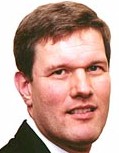
Harold
Furchtgott-Roth
Study Shows that People in Areas with Higher Sales Taxes Buy More
on the Net
(March 19, 1999) A statistical study of buying habits shows that consumers who live in areas with higher sales taxes are more likely to make online purchases than those in areas with lower sales taxes. University of Chicago Professor Austan Goolsbee presented this finding in a seminar on March 19 at the American Enterprise Institute.
| See, PDF copy of In a World Without Borders: The Impact of Taxes on Internet Commerce, by Austan Goolsbee. |
Austan Goolsbee presented a paper at a seminar at the American Enterprise Institute in Washington DC on Friday morning, March 19. Goolsbee is a professor of economics at the Graduate School of Business at the University of Chicago. His presentation was titled "In a World Without Borders: The Impact of Taxes on Internet Commerce."
Prof. Goolsbee also estimated that applying existing sales taxes to Internet commerce would reduce the number of online buyers by 25 % and spending by more than 30%.
The study was based on a national survey conducted by Forrester Inc. in late 1997. Forrester questioned about 110,000 consumers about their technology decisions. The respondents were questioned about whether they owned computers, had online access, and had made online purchases. They were also questioned about their income, age, gender, education, and area of residence. The data on the about 25,000 people who reported having online access served as the basis of Prof. Goolsbee's study.
He next determined the local sales tax rate for each of these respondents. He made some assumptions, or guesses, as to which taxing jurisdiction some respondents lived, because the Forrester data did not provide exact addresses. 5,544 (or about 16%) of the people in the study had made online purchases.
He found that "people who live in locations with high sales taxes are significantly more likely to buy things over the Internet." He found that this remained the case, even when he controlled for a variety of demographic and other factors. For example, by controlling for income of the consumer, he could reject the hypothesis that sales taxes are higher in high income areas, higher income people make more online purchases, and therefore it is the high income, and not high taxes that causes people to spend on line.
| Econometric Gobbledygook |
Prof. Goolsbee used several multivariate regression models in which the dichotomous dependent variable was whether the individual consumer had made an online purchase (0 indicated no purchase, and 1 indicated that there had been at least one online purchase). The independent variables were the sales tax rate (actually, one plus the rate) and various demographic characteristics (such as age, sex, race, income, and others).
In all of several models the coefficient for the sales tax rate was positive, large, and statistically significant at convention levels. For example, in his probit model, this coefficient was .4554 and the standard error was .1546.
Applying the estimate of .4554 suggests that "raising the sales tax by .01 increases the probability of buying online by about .005," according to Prof. Goolsbee. "Since the mean probability of purchase is approximately .20, the estimated elasticity of online buying with respect to the tax price (one plus the tax rate) is 2.3."
Prof. Goolsbee's paper did not report a simple correlation coefficient for the two variables (whether a person had made an online purchase and his local sales tax rate). Nor, did it display any simple percentages, such as the the percentage of people in localities with no sales tax who had made an online purchase, and the percentage of people in high sales tax localities who had made an online purchase.
| Reaction from the Panel and Audience |
At the conclusion of his presentation, Prof. Goolsbee received comments from a three member panel, and questions and comments from the audience.
 |
|
Harold |
Harold Furchtgott-Roth, who is a Commissioner on the Federal Communications Commission, sat on a panel that discussed Prof. Goolsbee's paper. He concluded that "he has made a very important contribution to our understanding of these markets." He also encouraged Prof. Goolsbee to examine other aspects of electronic commerce as well.
Furchtgott-Roth, who is also an economist, stated that the government should not be picking winners among competing distribution channels. "The tax system should not be distorting the choices, either from the business side, as to which to employ, or as to the consumer side, as to which to employ."
Justin Lilley, the telecommunications counsel for the House Commerce Committee, also sat on the panel. However, he devoted most of his comments to promoting the notion of the Internet Tax Freedom Act, and discussing upcoming Internet legislation in Congress.
Joann Weiner of the U.S. Treasury Department attended the event. She expressed surprise at the strong relation which Prof. Goolsbee found between sales tax rates and the probability of making online purchases. She stated that Treasury Department studies did not find such high elasticities. Goolsbee responded that this was because IRS taxation applies everywhere, and Americans cannot avoid it. In contrast, local sales taxes can be avoided by people with Internet access, or who live close to borders with jurisdictions with lower sales tax rates. Hence, studies of border communities, and his study, found high elasticities.
| Related Story: Gingrich Addresses Internet Taxes and Tax Commission, 3/19/99. |
Former House Speaker Newt Gingrich, and now American Enterprise Institute Senior Fellow, was present at the event and discussed the Commission created by the Internet Tax Freedom Act.
About one hundred people were present for the event. The audience included AEI personnel, Congressional staff, Treasury Department staff, and representatives of telecommunications companies, brokerage and consulting firms.